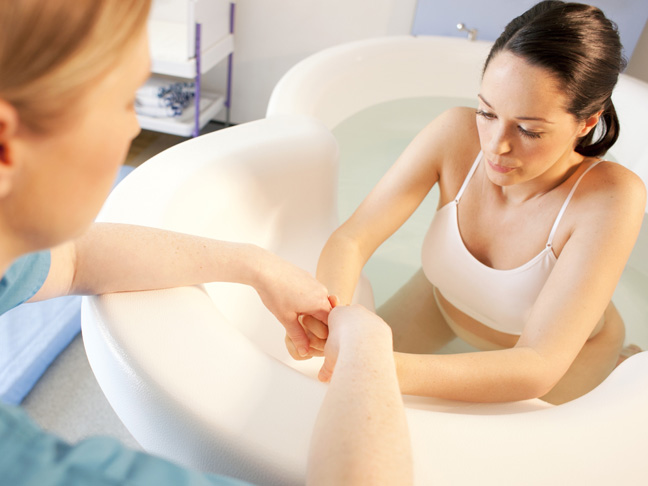My family and I have recently moved from Brooklyn, New York, to Bradford-on-Avon, England, for a year. Our mission: try out life at a slower pace. In my new series Brooklyn to England, I’ll write about the weekly adventures of living in the English countryside with my British husband, our three-year-old daughter, and my newborn. Come with me as I go from strollers to prams, diapers to nappies, and whatever else it takes to raise a family abroad.
When I woke up Sunday at 4 a.m. with strong contractions — a week before my due date — I thought it was a false alarm.
“No, I really think you’re in labor,” my husband said, watching me wince and grit my teeth every four minutes like clockwork. “Call the hospital,” he added, and handed me the phone.
A mild-mannered nurse agreed. Second babies often come quicker, and she suggested I make my way in to the hospital ASAP. Well, this was not part of my ideal labor plan but I did as I was told. I had been hoping the baby would come on Tuesday. Tuesday would be after Trixie and I attended The Queen’s Knickers (a kids musical) on Sunday, and after my booked-long-in-advance dermatologist appointment on Monday. Tuesday worked for me.
Sunday, however, worked for the baby. At 5 a.m. we dropped Trixie off with her granddad and drove through the empty, pre-dawn streets to the Royal United Hospital in Bath. Hobbling into the Princess Anne maternity wing between two-minute-apart contractions, the first thing Andy and I noticed were the screams — heinous, blood curdling shrieks echoing out of delivery suites and into the vacant hallways as women were tortured labored nearby.
“Jesus,” I gasped, but there was no time to dwell. With my legs spread wide, my midwife (a total stranger, because prenatal, labor, and postnatal care are handled by different midwives in the UK) told me I was about 8cm dilated. In a haze of pain I muttered the words “water birth,” and the squat, mousy brunette shuffled off to fill the tub — which took forever to fill, by the way. Water dribbled from the tap like the wheezy remnants of a kids juice box. Even the midwife seemed to think it wouldn’t fill in time.
“You could labor on the bed,” she suggested. “Or squat, or get on all fours?”
“No,” I bristled. My homebirth dreams had already been quashed; the least I could do was labor aquatically. “I’ll wait.”
While we waited, I thought about Buckethead. He’s a guitarist known for wearing an expressionless white mask and KFC bucket-hat, and we’d been up late watching his music videos the night before. A contraction rolled through me and I wondered about the bucket. Was it an affront to vegetarians? Did the bucket combat stage fright? Within seconds the pain was so severe I realized I didn’t give a crap about Buckethead or his greasy cardboard helmet.
“Do you want gas-and-air?” the midwife asked softly.
This I was eager to try. Quickly I nodded and accepted the portable oxygen and nitrous oxide mask. Gas-and-air is the go-to pain relief in the UK. In the scheme of things, it is lowest on the totem pole, followed by the nerve-stimulating TENS machine, pethidine (morphine), or what we in the U.S. are all familiar with, the epidural. Gas-and-air, aka laughing gas, is supposed to have a calming effect, but with each sharp inhale, all I felt was a buzz of nervous energy. Thanks for making me feel like I drank seven cups of coffee, gas-and-air.
Soon, a mega-contraction rippled through me. “I think I need the bathroom,” I groaned.
My midwife stopped in her tracks. “The toilet?” she said. “What? Don’t sit on the toilet.” At first we thought she must be kidding, but she explained, “If you think you need a poo, it probably means the baby’s coming. You don’t want your baby born there, do you?!”
Point taken. So, with Andy’s hands digging firmly into my lower back, we made our way across the delivery suite and into the ¾ full tub.
“What do I do?” I asked, taking another swig of gas-and-air, which, although ineffective, did alert my husband that another contraction was ahead.
“What do you feel like doing?” the midwife asked.
I looked at Andy for the answer. He shrugged.
“Uh, I guess I could push?” I finally said, wondering if this was a test, and if I would pass.
She shrugged. “Okay then, give it a try.”
Part of me appreciated her laidback, hands-off approach to midwifery, but another part of me just wanted to grab her by the scrub lapels and scream, “You’re the midwife! Tell me what the fuck to do!”
But it was up to me. And, actually, that was kind of cool. I pushed when I felt like it; I bossed my husband around; I changed positions when the urge struck. I took charge (I mean, while screaming bloody murder and begging the midwife to ‘Get this thing out of meeee!’)
Ten minutes later the tub had finally filled and I was looking at a grapefruit-sized human head between my thighs. “Can it breathe?” I sputtered, reveling in the sensation of my baby’s body wriggling inside me as its noggin swiveled in the water.
“It’s not breathing yet,” the midwife replied calmly.
How the hell could she be so calm? There was a frigging head twisting around between my thighs!
“One more push,” she said—or, like, mildly suggested, I guess.
With Andy’s hand still dedicatedly rammed into my lower back, I did as I was told. A few seconds later, out came the body, and I pulled a total stranger from between my legs and into my arms.
Andy cut the slimy, gelatinous umbilical cord and then looked between the baby’s legs. “It’s a boy!” he cried.
No way. Even though we suspected we’d have a boy, and our family and friends thought we’d have a boy, and even my mother’s psychic in Santa Fe predicted a boy, I was still in total shock that it was, indeed, a boy. A remarkable boy named Harvey, we later decided.
Though the next few hours were a blur, some things stick out in my mind — especially when comparing this experience to childbirth in America. For one, the nurses never took Harvey away. Not to warm him or weigh him or clean him or to give me a chance to rest. Never. Your baby stays with you the whole time, which would be a frigging miracle at a US hospital. Also, we were released three hours after Harvey was born. Three hours! Think about it: While you were at the multiplex seeing ‘Interstellar’, I was delivering a baby, staying long enough for vitals, cuddles, and a cup of tea, and then driving home with him in the backseat. Wow.
And the midwife. I joke, but she was amazing. It might seem glaringly obvious that midwives are incredible and invaluable, but two weeks after Harvey was born there was a Midwife Strike in England over a one percent pay increase. One percent? Frigging give it to them, right? But apparently one percent is a tall order (in a world where the MPs have been recommended to get a 10 percent pay increase — insanity!).
So, that’s it. That’s my birth story. Even though it didn’t fit in with my ideal labor plan, everything worked out pretty well. Trixie’s granddad took her to see The Queen’s Knickers (“Mummy, there were knickers everywhere!”), and I kept my booked-long-in-advance dermatologist appointment, too.
“Ms. Richards?” the doctor said, calling me into his office a mere 30 hours later. “This way.”
“Coming,” I said, then added, “Sorry,” when I realized how slowly I must’ve been walking. “I gave birth yesterday.”
It was worth it just to see the look on his face.








